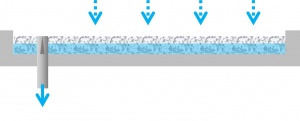Difference between revisions of "Blue roofs"
Jenny Hill (talk | contribs) |
Jenny Hill (talk | contribs) |
||
| Line 24: | Line 24: | ||
==Resources to review== | ==Resources to review== | ||
| − | <ref>Richard Hammond (2017). Evaluating Green and Blue Roof Opportunities in Canadian Cities. UWSpace. http://hdl.handle.net/10012/11463</ref> | + | Examples of roof failures due to water ponding have led to formal declarations being required from building designers as part of permit applications across Canada, confirming whether roof control drains are proposed and that appropriate measures (including structural capacity, number of drains, and overflows) have been taken (EABO, 2016). Because all roofs in Canada must be designed to support peak snow loads, this provides capacity for supporting an equivalent weight of ponded water. Building codes permit designers to assume that snow and water loads are not cumulative, up to a maximum depth of 150mm of water, if precautions are taken to prevent flooding by providing a sufficient number of roof drains with overflows. It is therefore uncommon for roof water detention systems to be designed to permit more than 150mm of water to accumulate. This also means that these systems can be incorporated into existing roof structures that have been designed to support conventional snow loads.<ref>Richard Hammond (2017). Evaluating Green and Blue Roof Opportunities in Canadian Cities. UWSpace. http://hdl.handle.net/10012/11463</ref> |
| + | |||
| + | |||
<ref>https://www.pwdplanreview.org/manual/chapter-4/4.6-blue-roofs</ref> | <ref>https://www.pwdplanreview.org/manual/chapter-4/4.6-blue-roofs</ref> | ||
Revision as of 00:49, 10 October 2018
Blue roofs can be a very economical and low maintenance way to manage unwanted rainwater on a flat roof. For rooftop retention on moderately sloped roofs, a green roof is going to be a better choice. On steeply sloped roofs, the best plan would be rainwater harvesting, or diverting roof leaders to a landscape integrated LID.
Overview[edit]
Blue roofs, or rooftop detention is a popular stormwater management option for many developments. The appeal is the relatively low cost and simplicity of modelling and forecasting performance.
Blue roofs are ideal for:
- Sites without significant space at ground level for infiltration,
- Zero-lot line projects with outdoor amenity requirements
The fundamental components of a blue roof are:
- A flat roof
- Flow control device(s)
Types of blue roof[edit]
Water can be slowed in running from a flat roof (up to 2%) through the use of:
- drain covers (most common),
- small check dams or weirs across the roof deck, or
- modular tray systems.[1]
The Ministry of Transportation do not currently permit blue roofs to form part of a SWM plan owing to concerns over long term maintenance; this affects relatively few projects[2]. The concerns arise from instances where building operators have found outlet control structures blocked with leaves or other debris. Without understanding the purpose of the device, these have been removed to prevent recurrence of the blockage. A study in New York City found that a modular system of trays outperformed an outlet flow control device in stormwater management[3]. It might reasonably be expected that a modular system would present fewer opportunities for complete failure from a single action, either through clogging or breakage of an storage element.
Blue roofs in the treatment train[edit]
Blue roofs can be used in combination with green roofs by employing a scaffold system to keep the vegetation rooting layer out of the ponded water. Blue roofs could also be employed in combination with a rainwater harvesting system which had daily usage demand. This could offset some part of the cistern capacity.
Resources to review[edit]
Examples of roof failures due to water ponding have led to formal declarations being required from building designers as part of permit applications across Canada, confirming whether roof control drains are proposed and that appropriate measures (including structural capacity, number of drains, and overflows) have been taken (EABO, 2016). Because all roofs in Canada must be designed to support peak snow loads, this provides capacity for supporting an equivalent weight of ponded water. Building codes permit designers to assume that snow and water loads are not cumulative, up to a maximum depth of 150mm of water, if precautions are taken to prevent flooding by providing a sufficient number of roof drains with overflows. It is therefore uncommon for roof water detention systems to be designed to permit more than 150mm of water to accumulate. This also means that these systems can be incorporated into existing roof structures that have been designed to support conventional snow loads.[4]
Providers[edit]
In our effort to make this guide as functional as possible, we have decided to include proprietary systems and links to manufacturers websites.
Inclusion of such links does not constitute endorsement by the Sustainable Technologies Evaluation Program.
Lists are ordered alphabetically; link updates are welcomed using the form below.
Flow control devices[edit]
Other[edit]
These products are designed to suspend green roof (or other) systems above a layer of free water for the detention period.
- ↑ Massachusetts Clean Water Toolkit, Rooftop Detention (Blue Roofs), Retrieved 9 October 2018 from http://prj.geosyntec.com/npsmanual/rooftopdetentionblueroofs.aspx
- ↑ Ontario Ministry of Transportation. (2016). Stormwater Management Requirements for Land Development Proposals. Retrieved March 7, 2018, from http://www.mto.gov.on.ca/english/publications/drainage/stormwater/section8.shtml#controls
- ↑ Bloomberg, M., & Strickland, C. H. (2012). NYC Green Infrastructure Plan: 2012 Green Infrastructure Pilot Monitoring Report. New York. Retrieved from http://www.nyc.gov/html/dep/pdf/green_infrastructure/2012_green_infrastructure_pilot_monitoring_report.pdf
- ↑ Richard Hammond (2017). Evaluating Green and Blue Roof Opportunities in Canadian Cities. UWSpace. http://hdl.handle.net/10012/11463
- ↑ https://www.pwdplanreview.org/manual/chapter-4/4.6-blue-roofs
